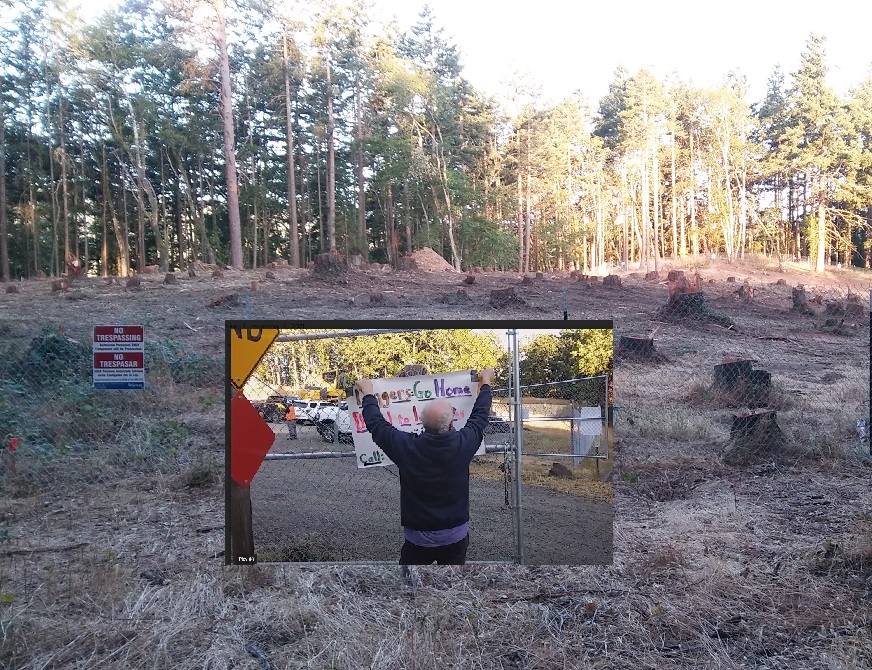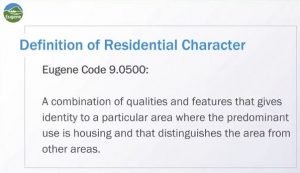Patterson Hill neighbors say a final farewell to the big trees
4 min read
Ken Rothman (inset) removes a protest sign as EWEB was allowed to proceed with the East 40th Water Storage Project.
Ken Rothman came to say goodbye to an old friend.
[00:00:03] Ken Rothman: This tree is quite a large Ponderosa pine and I have a particular affinity for it. I’ve come by it on walks many times and very much enjoy this tree’s presence. It’s only maybe 10 feet from the construction fence. I don’t see why they couldn’t leave just a few trees like this and avoid it when they’re constructing this tank.
[00:00:25] John Q: Ken was visiting the East 40th Water Storage Project site, just after LUBA dismissed an appeal, allowing logging to proceed.
[00:00:34] Ken Rothman: It’s one of, I think, of 12 remaining trees out of the 265 they cut. So they cut 253 and they’re planning to cut these other 12 today.
[00:00:44] John Q: He pointed out one of the last standing giants, which neighbor Sandra Bishop calls “the Mother Tree.”
[00:00:50] Ken Rothman: This is the biggest tree in the grove. You can see by the form it has, it was once a lone wolf, which means that it was a kind of a tree that was growing without competition. You can tell by the existence of branches down this low. And I wish they’d leave that, although I can understand that it’s further into the construction zone. Or this one is almost as big which is just within a few feet of the other fence, you know, um, why can’t the fence be just a tiny bit that way. Obviously that one tree wouldn’t make a difference to the construction site.
[00:01:26] John Q: The Mother Tree was still standing, but had experienced the first chainsaw cut, as Ken spoke.
Thank you for supporting
local citizen journalism
[00:01:33] Ken Rothman: Anyway, this tree I’ve heard from neighbors that it was a place where kids used to build tree forts 50, 60 years ago. And they did put a chain saw into it, and the story was, I don’t know for sure, I didn’t talk to the logger that did it, that he hit an old spike in it, which is possibly from one of those old tree forts. I talked to a lady here in the neighborhood whose son used to play hooky from Spencer Butte Middle School. Sometimes when she’d catch them. 50, 60 years ago and up here and several other people who’ve lived in this neighborhood and this little grove of trees was an anchor in the neighborhood. In the hot weather, if you walk under the shade here, it was a lot cooler. I I imagine it was 20 degrees cooler under here than in the sun.
[00:02:28] John Q: To build both 7.5 million-gallon water tanks, the Douglas firs are being removed.
[00:02:35] Ken Rothman: There is a point to be made that this is not the culturally traditional forest in this area; that when the Kalapuya were stewarding this land, they burned the young Doug firs so that to promote Oak Savanna, like what EWEB preserves most of over there, although they did take two log trucks of oak out of here. But they preserve most of the Oak Savanna, which is what the Kalapuya had here. That was a Food crop and it uses less water. And so there’s an argument to be made that this type of forest traditionally didn’t really belong here. Even this old tree is maybe 160 years.
[00:03:18] John Q: Ken thinks other projects should take higher priority.
[00:03:21] Ken Rothman: But I think that it, what we should do, after the Holiday Farm Fire almost came to our only source of water for the whole city and on the McKenzie last fall that we should be establishing a diverse source of water for EWEB, possibly another water gathering point on the Willamette instead of on the McKenzie, which I understand that they have explored in the past and stopped. That should, that I think should be our infrastructure development priority more than building a tank that would most provide one day worth of water for the city, building two tanks that would do that, which you know, I maybe both, but this is happening now. It seems and I can’t even fathom the economic structures underneath, what the rationales are for spending so much on this particular infrastructure. Now I do know that the tanks on College Hill and Hawkins Hill, especially College Hill, are old and not earthquake safe, and need to be replaced. They can’t be repaired. I don’t understand why these tanks couldn’t have been built next to those without taking down so many trees while those were demolished and new ones put up. Apparently this is happening.
[00:04:37] John Q: The Mother Tree and others came down on Friday, as friends and neighbors mourn their loss.



